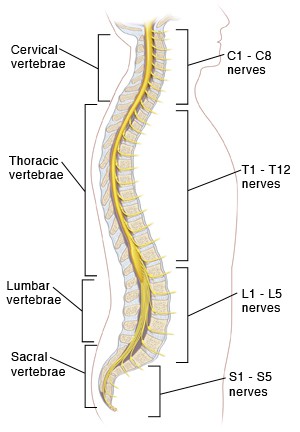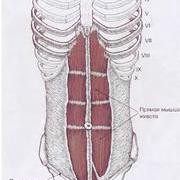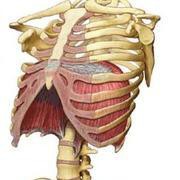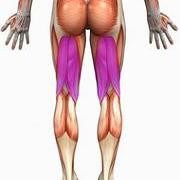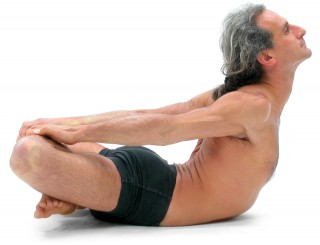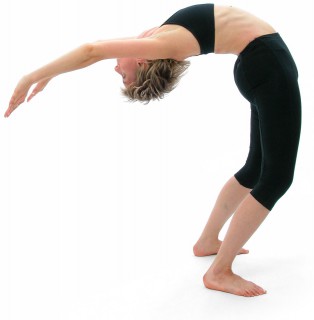With unpretentious "infographic" and a selection of photos show us the steps of performing backbends that will help you to involve the most rigid part of the back for most people - between T10 and L4. As well as to use in bending forward the area of the vertebrae L5-S1, where most people have tendency for compression.
Most modern adults tend to have very stiff middle backs (usually from about T10 to L4 that tends to be often stuck in a slight forward bend (spinal flexion)). These people often do most of their bending backwards (spinal extension) from the very lowest part of the mobile spine at L5-S1, which is usually about 2 centimetres below the top of your hips (iliac crests). Since this part of your spine is below the top of the hips it is actually very hard to relieve compression their by bending the spine forward because when most people bend forward they simply bend forward at the hips, which is something we are very good at doing because of our primarily seated lifestyle.
This loosely put together ‘info-graphic’ describe the steps you can do in a backward bending posture that will help you bend backwards where most people tend to be stiff—between T10 and L4, while bending forward where most people tend to be compressed at L5-S1.
The solution relies on gaining control of and learning to use a combination of the following important muscles:
- Psoas major — bends the hips forward (hip flexor activity) and also bends the spine backwards (spinal extensor activity).
If the psoas is over tense or in spasm it can be the cause of lower back pain because it will pull the L5-S1 joint of the lower spine into a backbend (spinal extension).
Rectus abdominis — the abdominal ‘six pack’ muscle that can keep the front ribs inwards and is the main muscle of bending forward which when active can help to reciprocally relax you back muscles, which are often too tense.
The diaphragm — the main muscle of breathing, which when used makes you more relaxed and make you feel like you are breathing into the abdomen.
Hip extensors (such as the backside muscles and the hamstrings) — these muscles can help to stop the hips from bending forwards and help to prevent the psoas muscle from hyper-extending L5-S1 and causing lower back pain.
It is possible in any back bending position to use a combination of muscles to prevent the hips from bending forward (enhances hip extension), which thus helps to prevent the L5-S1 from bending backwards. The simplest instructions to get this effect are to move sitting bones forward (towards the belly), the top of the hips backwards (away from the belly) and move the navel forward.
Moving the navel forward can be done using a combination of the diaphragm and/or the rectus abdomens. This action tends to also pull the L5 vertebra slightly forward and can relieve lower back compression. This action can be trained if you practice abdominal inhalation while doing a half sit up or practicing abdominal inhalation while carefully dropping part of the way down toward the floor as if you are about to ‘drop back to Urdhva Dhanurasana (the ‘Inverted bow posture’) or more safely and simply for most people to Ustrasana (the ‘Camel posture’).
Once you can immobilise the hips in extension and breathe into the abdomen, especially if your rectus abdominis is active, and holding your front ribs inwards, you usually start to feel the middle of your back beginning to bend backwards (sometimes for the first time since being a child) while actually relieving any compression around L5-S1.
This is largely due to two main reasons:
- The fact that the psoas muscles actually join onto the transverse processes of the vertebrae T12-L5 (see anatomy photo) and can therefore bend the spine backwards at these vertebrae if they are not allowed to make L5-S1 bend backwards.
- The fact the diaphragm is a dome-shaped muscle that actually joins onto the psoas (see anatomy photo) and so when the diaphragm becomes active (i.e. when it contracts as you inhale into the abdomen) it pulls on the psoas and even causes the psoas to become active (via the ‘stretch reflex’), which will cause the T12-L5 begin to bend backwards.
You can apply these principles in any backward bending (spinal extension posture (even while simply standing up straight).
In the photos attached you can see me using this method while doing Baddha Hasta Janu Simhasana (grabbing my knees in a ‘lotus cobra’) and you can see how I bending inwards in my mid spine quite fully (this feels incredible in fact—like an incredible self-massage). In the other photo you can see a model dropping backward into a backward arch. While slowly lowering down the rectus abdominis is very active and so no ribs can stick out. Once you feel your ribs sticking out in a back arch you can be pretty sure your L5-S1 has been compromised. This is of course what happens to most people once they touch the floor in a back arch. In fact there is less risk of injury while lowering to a back arch from standing than there is once you touch the floor. This is of course hard to control and much easier to do in the camel pose. The real art is to keep the rectus abdominis on while in the back arch or while in camel pose or any back bending posture.
How to ‘open’ your mid-spine in any ‘backbend’ & How to not squash your lower back:
- Lengthen the psoas muscles at the hips (hip extensions) & immobilize L5-S1 (i.e. don’t let your lower back compress)
- Activate the rectus abdominis (tha-mula bandha) as you would if you slowly lower down (‘drop back’) to Urdhva Dhanurasana (‘inverted bow posture’) or slowly lower down to Ustrasana (the “camel posture’)
- Breathe in to your abdomen (use your diaphragm)
- Breathe out from your chest (ha-uddiyana bandha)
- If you breathe into the abdomen (diaphragmatic breathing) when the psoas muscles are held in a lengthen state over the hip joint, then the psoas muscles can extend your spine (bend backward) from T12-L4, because the diaphragm attaches to, pulls on and gives ‘stretch reflex activation’ of the psoas muscles (which join t T12-L5)
- Here the psoas muscles can also flex the spine at L5-S1, relieving most lower back pain & encouraging flexibility in the stiffer regions of the spine.
If you want to learn more about postures and breathing on our online courses:
our more theoretical course at : http://anatomy.yogasynergy.com/
and our more practical course : http://fundamentals.yogasynergy.com/



